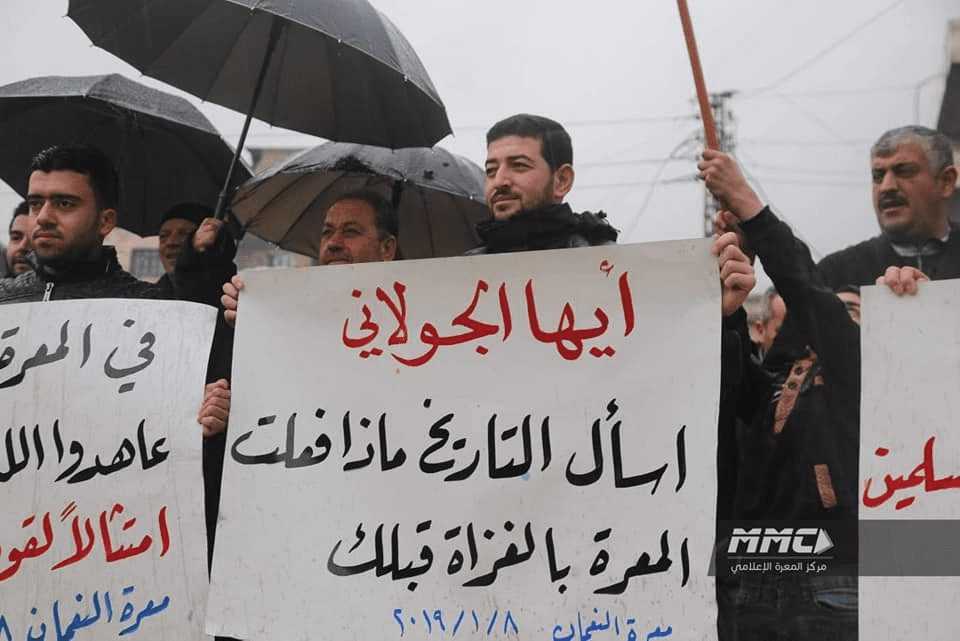HTS continues offensive against areas of rebel-held northwest, ‘cutting off’ and seizing nearly a dozen towns from factional rivals
AMMAN: Hardline Islamist fighters from Hay’at Tahrir a-Sham seized nearly a dozen towns and villages from rival Syrian opposition factions in the country’s northwest Tuesday morning, as inter-factional clashes continue to tip the balance of power across the rebel-held region for a second week.
8 January 2019
Residents of Idlib province's Maarat a-Numan demonstrate against HTS on Tuesday. Photo courtesy of Maarat Media Center.
AMMAN: Hardline Islamist fighters from Hay’at Tahrir a-Sham seized nearly a dozen towns and villages from rival Syrian opposition factions in the country’s northwest Tuesday morning, as inter-factional clashes continue to tip the balance of power across the rebel-held region for a second week.
Forces from Hay’at Tahrir a-Sham (HTS) captured ten villages and towns in southwestern Idlib and northwestern Hama provinces from opposing rebel groups since early Tuesday morning, the latest in a string of military and political victories for the coalition.
HTS is an Islamist coalition spearheaded by a former al-Qaeda affiliate previously known as Jabhat a-Nusra. The group is one of the most powerful opposition factions remaining in Syria, boasting thousands of fighters—including a significant portion of foreigners—and heavy weaponry.
HTS, which wielded authority over roughly 60 percent of Idlib province before the latest bout of inter-factional clashes, also exerts significant local influence via its affiliated governance body, the Syrian Salvation Government. The group has been designated a terrorist organization by the US, Turkey and others.
The infighting largely centers around two main rebel blocs, with HTS and its allies on one side, and a loosely affiliated coalition of Turkish-backed rebel factions under the umbrella of the National Liberation Front (NLF) on the other.
HTS advances in the past week have chipped away at NLF territory in northwestern Syria, with its forces capturing a number of key towns and infrastructure in both Aleppo and Idlib provinces.
The recent moves by HTS appear to signal an attempt by the rebel coalition to push for regional dominance in Syria’s last remaining opposition stronghold, by intimidating its local rivals and reasserting itself militarily in rebel-held areas of Aleppo and Idlib provinces.
In October, a Russian- and Turkish-brokered agreement over the fate of Idlib province went into effect across northwestern Syria, with rebel factions reportedly removing heavy weapons from a 15- to 20-kilometer-wide buffer zone surrounding rebel-held Idlib province.
NLF areas ‘cut off’
Though the agreement seemingly staved off a widely anticipated pro-government operation to recapture Syria’s final rebel-held stronghold, inter-factional divisions and long-standing bad blood between rebel groups on the ground have complicated its implementation. Relations between the two rebel blocs have deteriorated rapidly since.
The relationship between the NLF and HTS reached a breaking point last weekend, when a major HTS assault on NLF-affiliated Harakat Nour a-Din a-Zinki pushed the faction to the brink of collapse.
In the wake of advances on NLF-held towns and villages, HTS blocked key routes linking NLF territory in the northwest.
On Tuesday, HTS erected roadblocks and checkpoints on major roadways connecting remaining NLF territory in Sahel al-Ghab, a fertile expanse of agricultural flatlands stretching across northwestern Hama and southwestern Idlib provinces, journalists and activists in the area told Syria Direct.
“All the roads in Sahel al-Ghab are cut off,” Mustafa Abu Arab, a Syrian activist based in Hama province, told Syria Direct
All paths from the area towards nearby NLF-controlled zones in Idlib and Hama are also blocked by HTS, prompting fears among local residents that fighting is set to continue, he added.
By Tuesday afternoon, only one area of Sahel al-Ghab—Jabal Shahbo—remained “entirely” under NLF control, Muhammad Rashid, a the head of the coalition’s media office, told Syria Direct.
He meanwhile declined to comment on military developments “until all the details become clear.”
‘Hey Jolani!’
Jabal a-Zawiya lies in southern Idlib province east of Sahel al-Ghab, and is controlled by rebels hostile to HTS. The group’s rapid advance across the northwest in recent days has startled the area’s residents, local sources say.
“The people are in a state of fear,” Abu Rami, a local government official in the Jabal a-Zawiya area of southwestern Idlib province, told Syria Direct, describing a climate of “fear and panic” among the area’s residents despite the fact the situation in Jabal a-Zawiya remains stable for now.
Abu Rami requested that his real name and location be withheld, also fearing reprisals should HTS take control of the area.
According to local news outlets and media activists in the area, HTS mobilization in the area around Jabal a-Zawiya and the nearby city of Maarat a-Numan prompted the city’s residents to organize protests against the hardline coalition.
“Hey Jolani!” read one of the demonstrators’ signs at the Maarat a-Numan rally Tuesday, referring to HTS leader Muhammad al-Jolani. “Ask history what [Maarat a-Numan] did to the invaders that came before you.”
Maarat a-Numan, Idlib province’s second largest city, is located along the M5 international highway that bisects Idlib province towards ِAleppo city, along a key artery for local and international trade that has become a vital strategic goal for rebels and pro-government forces alike.
“These are important areas,” said NLF spokesperson Abu Faisal. “[HTS] is trying to put pressure on them.”
“It’s trying to seize all rebel territory.”
The latest round of clashes between HTS and NLF groups first broke out on January 1, when HTS attacked NLF positions in western Aleppo province.
In the following week, the hardline coalition seized a number of major Aleppo towns, including Darat Izza and al-Atareb, leaving more than 100 dead on both sides.







